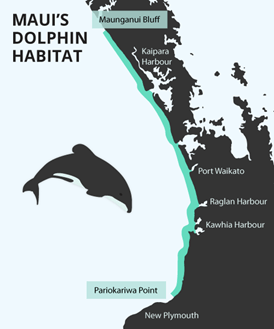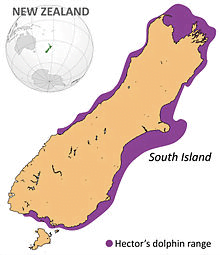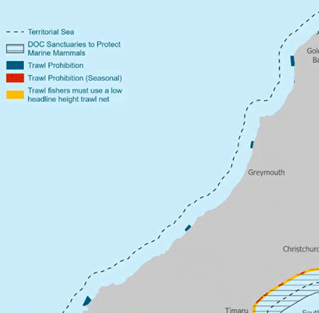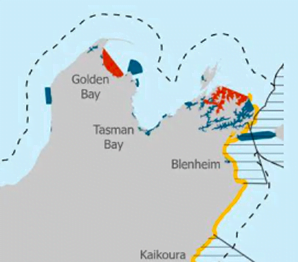How much do you know about the different Hector’s Dolphin populations around the country? Where exactly do they live? As an ecotourism operator local to Canterbury, we are obviously guilty of focusing on the 1000 or so dolphins that live around our harbours. Banks Peninsula is of special importance to us, being our home for nearly 40 years. Fortunately, Hector’s Dolphins can be found all around the waters of New Zealand. Today’s blog aims to help you understand a little more about other populations of Hector’s Dolphins beyond the Banks Peninsula area.

NORTH ISLAND DOLPHINS
You may not be aware of an incredibly rare subspecies of the Hector’s Dolphin known as the ‘Maui Dolphins’. They are very similar, but are thought to have been isolated from each other for around 16000 years. Māui dolphins have very slightly larger skulls than Hector’s dolphins and a longer, wider rostrum or snout. With only 56 individuals alive today, they are the rarest marine mammal on the planet. They live in a very small area on the western side of the North Island. The entire species’ survivability rests on 9 female dolphins of calf-rearing age.
Hector’s Dolphins are rarely sighted in the North Island. This is why it’s so important we look after the Maui’s Dolphin subspecies. They are only found on the west coast of the North Island from the New Plymouth area to Maunganui Bluff. Despite their extreme rarity, Maui Dolphins are still in huge danger of being caught in nets from commercial fishers. Bans only exist a few kilometres off shore, but Maui Dolphins go far beyond this area. With the Maui dolphins being even rarer than the kākāpō, should we be risking the death of a single animal, when each one is essential to the overall survivability of the species?
WEST COAST DOLPHINS
As seen in the map on the right, Hector’s Dolphins can be found almost all around the coasts of the South Island.
Black Cat Cruises have always pushed for more protection in our local waters from fishing nets. But we’re still leagues ahead of the West Coast. Namely, nothing in the recently released TMP addresses the areas along the West Coast. Whilst this area has a lower concentration of Fishers, it is unacceptable that they can still operate here almost unhinged. Pictured below are the current areas which ban trawl netting on the West Coast. This will remain completely unchanged following the integration of any of the proposed Threat Management Plan’s options. This area is the least documented area when it comes to Hector’s Dolphins. However, it doesn’t take a marine biologist to see that there are massive areas where Hector’s Dolphins are threatened by trawl netting. Set net bans are only enforced a few kilometres offshore, and don’t go far enough to cover the dolphin’s habitat.



NORTH OF THE SOUTH ISLAND
The Northern tip of the South Island is also home to a large proportion of our remaining Hector’s Dolphins. Alongside Akaroa and Kaikoura, this area provides the best chance for one to encounter a Hector’s Dolphin. However, net-fishing is also common in this area. Pictured below are the current areas which ban trawl net fishing (blue is permanent and red is seasonal). The seasonal ban is an interesting compromise between fishers and conservationists; It protects Hector’s Dolphins in the times they are most likely to be in those areas, whilst still giving Fishers a chance to make a livelihood. The seasonal ban could be an immediate but temporary solution for waters which are currently open to fishers all-year round. This would reduce the chances of Hector’s dolphins being caught as New Zealand gradually transitions to complete bans in waters less than 100M deep. This is what the International Union for the Conservation of Nature has recommended, and we currently remain within the 8% of countries which have ignored their advice.
THE SOUTHERN TIP
The bottom of the South Island is home to the smallest population of Hector’s Dolphins, possibly in the low hundreds. However, fishing is a popular industry in Southern towns, and dolphins have certainly been caught in fishing nets in these areas. The Northern and Southern tips of the South Island have had some expansions to restrictions, similar to what will happen around Banks Peninsula. Further restrictions to Trawl-netting (such as smaller net openings and a slower speed) may be enforced in additional areas.
Globally, scientists are saying we need to put aside 30% of our oceans for biodiversity to remain. Only 0.4% of the ocean New Zealand control is protected, according to Livia Esterhazy (WWF NZ). Hector’s Dolphins are far more than a beautiful animal for humans to enjoy. They are an apex predator and without them, the entire ecosystem of New Zealand’s coasts would crumble. If states like California and countries like Finland can fully ban set-nets, what’s New Zealand’s excuse?
WHAT CAN YOU DO RIGHT NOW?
Did you know that there is less than a week left for public submissions to the Ministry for Primary Industries? Please click on this link, follow the instructions, and in less than 3 minutes, YOU can make a difference. If enough like-minded people email their opinions on their Threat Management Plan, (we have a template you can use) the MPI will have to listen and make positive changes.
Click Here to Help the hector's dolphins of new zealand